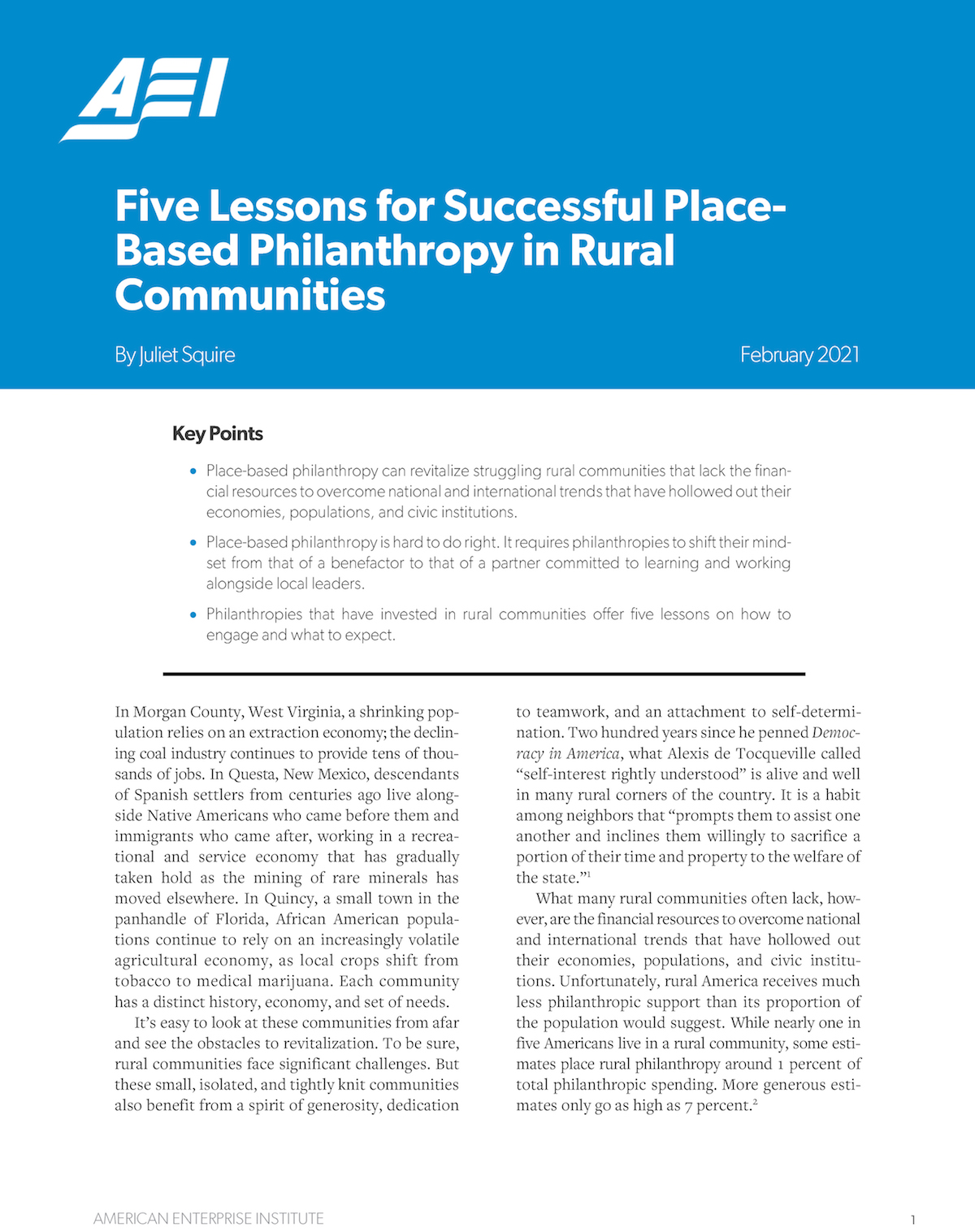
For many years, rural education has been a back-burner issue. For decades, education reformers have focused on urban school systems, which are big and highly visible. Meanwhile, even as businesses have departed rural communities, leaving them isolated and impoverished, their educational challenges have drawn scant notice.
What can be done about this? In a new essay for AEI Education’s Place-Based Philanthropy series, Bellwether Education’s Juliet Squire, who has done a lot of work with funders and rural communities in recent years, sketches a number of ideas on how philanthropy can better help rural communities.
These communities, Squire points out, need resources and support. However, funders inclined to step up are rarely from rural America, and they can too readily breed resentment by coming across as self-impressed, wealthy, cosmopolitan know-it-alls (not that this reaction is unique to rural communities, of course; plenty have raised similar concerns in places like Newark, N.J., and New Orleans).
Hoping to do better, donors are contemplating place-based approaches, in which they focus on one rural community at a time. Squire believes that, done right, this place-based approach has “enormous potential to revitalize rural communities.” Because this approach “requires philanthropies to shift their mindset from that of a benefactor to that of a partner committed to learning and working alongside local leaders,” it helps mitigate the resentment often caused by outside philanthropists, while still providing the rural communities the support they need.
The trick is, it’s tough to get this sort of approach right. Squire offers a number of suggestions. Three particularly stuck out to me.
First, philanthropy requires local capacity. In hard-hit rural communities, that can mean building from the ground up. In urban locales, philanthropies tend to partner with local nonprofits since established groups are more likely to understand the culture and needs of their community, to be known by local leaders, and to continue the work after a donor has moved on. But in struggling rural communities, Squire points out, civil society has frequently been hollowed out. This means philanthropies can’t rely on partners but wind up trying to build local connections and credibility on their own. A place to start, Squire suggests, is showing one can help by providing tangible things—like playground equipment. She says that only after donors have shown they can help are they able to earn the trust they need to move on to favorite funder activities like “conven[ing] community leaders” or “seed[ing] local partners.”
 Second, place-based giving requires “acknowledging the interconnectedness of community challenges and being willing to invest across multiple domains.” Squire observes that, because rural communities tend to be small, close-knit, and invested in a shared history, changes in one venue are likely to introduce unintended consequences elsewhere. For instance, as Squire illustrates, “A rural school may need to restructure its staffing, but eliminating positions is a vastly different proposition when the school is the largest employer in town.” In rural America, school improvement is inextricably linked to employment (again, this is true everywhere, but it’s a more urgent concern in locales where schools account for a huge fraction of the workforce). While funders may view the need to invest across multiple domains as a drawback, Squire says there’s a benefit, too; a community’s small size means that modest investments can go a long way. Moreover, rural communities are able to “act nimbly and independently,” meaning that positive change may happen more rapidly than in large, sprawling urban centers.
Second, place-based giving requires “acknowledging the interconnectedness of community challenges and being willing to invest across multiple domains.” Squire observes that, because rural communities tend to be small, close-knit, and invested in a shared history, changes in one venue are likely to introduce unintended consequences elsewhere. For instance, as Squire illustrates, “A rural school may need to restructure its staffing, but eliminating positions is a vastly different proposition when the school is the largest employer in town.” In rural America, school improvement is inextricably linked to employment (again, this is true everywhere, but it’s a more urgent concern in locales where schools account for a huge fraction of the workforce). While funders may view the need to invest across multiple domains as a drawback, Squire says there’s a benefit, too; a community’s small size means that modest investments can go a long way. Moreover, rural communities are able to “act nimbly and independently,” meaning that positive change may happen more rapidly than in large, sprawling urban centers.
Third, rural philanthropy requires setting aside preconceived notions of how to think about “impact” and “scale.” Foundations, relates Squire, “often quantify and evaluate [their] grants based on what, how much, and how well a grantee executed against expectations.” Squire believes that this translates poorly to small, fragile rural communities. She says that measuring impact in these communities usually involves a “more informal process,” where “interviews, focus groups, site visits, and trend analyses” can be more useful than formal reports. And when considering scale, Squire notes that, “a turnkey approach is antithetical to place-based philanthropy’s principal of community ownership.” She suggests that scale means showing other communities what’s possible and offering what they learned as a resource, not supplying a paint-by-numbers template.
There’s a lot of practical wisdom here. I hope funders and reformers looking to help rural communities will give Squire’s paper a read. And, having published three books on education philanthropy over the last couple decades myself, it strikes me that much of what Squire has to say should be heeded by funders working pretty much anywhere.
Frederick Hess is director of education policy studies at the American Enterprise Institute and an executive editor of Education Next.
This post originally appeared on Rick Hess Straight Up.
The post What’s It Take for Philanthropy to Help Rural Schools? appeared first on Education Next.
[NDN/ccn/comedia Links]
News.... browse around here
No comments:
Post a Comment